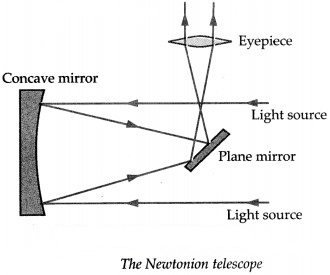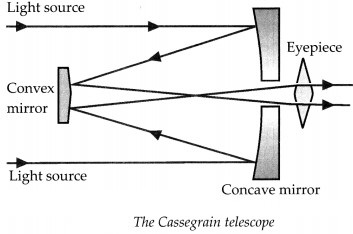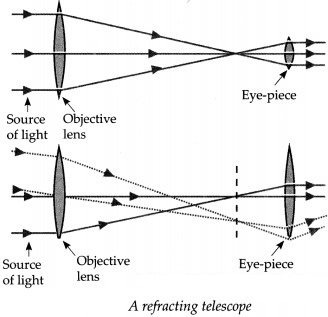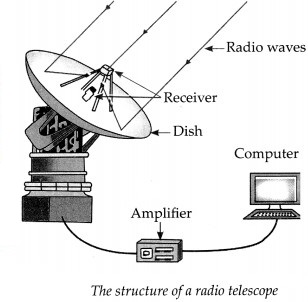Chapter 18 Observing Space: Telescopes
Textbook Questions and Answers
1. Fill in the blanks with the proper words.
a. The wavelength of visible light is between …………………..….. and …………………..…. .
b. GMRT is used for …………………..….. waves.
c. A certain X-ray telescope is named after scientist …………………..…. .
d. The first scientist to use a telescope for space observations …………………..…. .
e. The biggest optical telescope in India is situated at …………………..…. .
2. Form pairs
Column ‘A’ | Column ‘B’ |
(1) X-rays | (a) GMRT |
(2) Optical telescope | (b) ISRO |
(3) Indian radio telescope | (c) Hubble |
(4) Launching artificial-satellite | (d) Chandra |
Answer:
(1 – d),
(2 – c),
(3 – a),
(4 – b),
3. What are the difficulties in using ground-based optical telescopes? How are they overcome?
Answer:
Difficulties:
- The intensity of visible light coming from a heavenly body decreases due to absorption as it passes through the Earth’s atmosphere.
- Due to changes in atmospheric temperature and pressure light rays change their path.
- Because of sunlight, we cannot use optical telescopes during the day.
- During the night, city lights and cloudy weather cause difficulties.
Solution:
- To reduce these problems, optical telescopes are situated on top of mountains, in uninhabited places.
- To get rid of all the above problems completely, the telescope is placed above the earth’s atmosphere, in space.
4. Which type of telescopes can be made using a concave mirror, convex mirror, plane mirror, and a lens? Draw diagrams of these telescopes.
Answer:
-
A Newtonian telescope can be made using a concave mirror, plane mirror and a lens.

-
A Cassegrain telescope can be made using a convex mirror, concave mirror and a lens.

-
A refracting telescope can be made using two or more lenses.

5. Study the figure and answer the following questions:

a. What type of telescope is shown in the figure?
b. Label the main parts of the telescope.
c. Which type of mirror does the telescope use?
d. What other type of telescope uses a curved mirror?
e. Explain the working of the above telescope.
Answer:
(a) The Newtonian telescope (Reflecting telescope)
(b)

(c) Concave mirror
(d) The Cassegrain telescope
(e) Working.
- Light rays coming from space are reflected by the concave mirror.
- Before these reflected rays converge at the focus, they are deflected again by a small plane mirror.
- As a result, they get focused at a point lying on the perpendicular to the axis of the telescope’s cylinder.
- They pass through the eyepiece and we get a magnified image of the source.
6. Answer the following questions.
a. Explain the construction of Galileo’s telescope.
Answer:
- The Galileo’s telescope is made up of two or more convex lenses.
- The lens facing the object is called the objective lens which is made as large as possible to collect the maximum amount of light coming from a heavenly object.
- The lens closer to the eye is called the eyepiece which uses the light collected by the objective lens and produces a large image of the source.
- Such a telescope is also called a refracting telescope.
b. Explain the construction of a radio telescope.
Answer:
- The radio telescope is made from one or more dishes of a particular parabolic shape.
-
As in optical telescope, the incident radio waves are reflected by these dishes and converge at the focus.

- A radio receiver is placed at the focal point.
- The information gathered by this receiver is passed on to a computer which analyses it and constructs an image of the source.
c. Why are optical telescopes located in uninhabited places on mountains?
Answer:
- The visible light coming from a heavenly body has to pass through the earth’s atmosphere to reach the earth’s surface.
- During this journey, some of the light is absorbed by the atmosphere and the intensity of the light reaching the earth’s surface decreases.
- A second problem is caused by the changes in atmospheric pressure and temperature.
- These changes cause turbulence in the atmosphere which in turn cause the light rays to change their path slightly and thereby shake the position of the image.
- We cannot use optical telescope during the day. because of sunlight also.
- During the night too, city lights and cloudy weather can cause difficulties in observing the heavenly bodies.
- Hence, optical telescopes are located in uninhabited places on mountains.
d. Why can an X-ray telescope not be based on the earth?
Answer:
- X-rays are emitted from distant heavenly bodies.
- The rays coming towards the earth will be absorbed by the earth’s atmosphere and will go undetected.
- Hence, X-ray telescopes are placed in an orbit outside the earth’s atmosphere and not on the earth.
Intext Questions and Answers
Question 1.
What is meant by space observation? Why is it important?
Answer:
The observation of distant planets, galaxies and other astronomical objects is called as space observation.
- Various space based satellites support our telecommunication networks by providing us television broadcasting.
- Meteorology services such as weather forecasting help in disaster management.
- Observation of positions of stars and other heavenly bodies has helped in the study of solar system, solar winds, pulsars, supernova, etc.
Question 2.
What is the difference between sky and space?
Answer:
Sky: It is a layer of gas that surrounds the earth in which sunlight is scattered making it visible from the surface of the earth.
Space: The vast emptiness beyond the sky is called as space.
Additional Important Questions and Answers
Choose and write the correct options:
Question 1.
The first telescope was invented by
(a) Einstein
(b) Galileo
(c) Newton
(d) Mendel
Answer:
(b) Galileo
Question 2.
Eight is an wave.
(a) electric
(b) magnetic
(c) electromagnetic
(d) mechanical
Answer:
(c) electromagnetic
Question 3.
Visible radiation telescopes are also called as
(a) Gamma Ray telescopes
(b) Optical telescopes
(c) X-ray telescopes
(d) Radio telescopes
Answer:
(b) Optical telescope
Question 4.
Reflecting telescopes are mainly of two types : ……………….. and ………………. .
(a) Newtonian and Galileoan
(b) Optical and Cassegrain
(c) Newtonian and Cassegrain
(d) Optical and Refracting
Answer:
(c) Newtonian and cassegrain
Question 5.
Giant Meterwave Radio Telescope (GMRT) has been erected at near Pune.
(a) Asangaon
(b) Talegaon
(c) Narayangaon
(d) Bhategaon
Answer:
(c) Narayangaon
Question 6.
Visible light coming from heavenly bodies have to pass through the to reach the earth surface.
(a) stratosphere
(b) troposphere
(c) atmosphere
(d) biosphere
Answer:
(c) atmosphere
Question 7.
To collect the maximum amount of light coming from an object, the objective lens should be made as as possible.
(a) large
(b) small
(c) circular
(d) flat
Answer:
(a) large
Question 8.
The images formed by lenses have errors of colours. This is called
(a) chromatic disruption
(b) chromatic aberration
(c) chromatic reflection
(d) chromatic reaction
Answer:
(b) chromatic aberration
Question 9.
Radio telescope is made up of one or more dishes of shape.
(a) spherical
(b) hyperbolic
(c) parabolic
(d) hexagonal
Answer:
(c) parabolic
Match the columns:
Question 1.
Column ‘A’ | Column ‘B’ |
(1) X-rays | (a) GMRT |
(2) Optical telescope | (b) ISRO |
(3) Indian radio telescope | (c) Hubble |
(4) Launching artificial satellite | (d) Chandra |
(5) Radio waves | (e) telecommunication |
(6) INSAT and GSAT | (f) longer than 20cm |
Answer:
(1 – d),
(2 – c),
(3 – a),
(4 – b),
(5 – f),
(6- e)
Question 2.
Column ‘A’ | Column ‘B’ |
(1) Micro waves
|
(a) 800 nm – 0.3mm
|
Answer:
(1 – e),
(2 – a),
(3 – d),
(4 – b),
(5 – c)
Define the following:
Question 1.
Visible radiation
Answer:
Light is an electromagnetic wave. Every wave has a characteristic wavelength. Our eyes can see only that light which has wavelengths between 400 nm to 800 nm. Such light is called visible radiation.
Question 2.
Reflecting Telescope
Answer:
When light falls on the mirror, it gets reflected. Telescopes that use concave mirrors are called reflecting telescope.
Question 3.
Optical telescopes
Answer:
Telescopes which are made from regular lenses and mirrors and used to see visible radiations coming from space are called optical telescopes.
Question 4.
Refracting Telescopes
Answer:
Light rays change their direction as they enter a lens from the atmosphere and again when they enter the atmosphere after passing through the lens. This is called refraction. The telescopes that use such lenses are called refracting telescopes.
Question 5.
Radio telescopes
Answer:
Many heavenly bodies emit radio waves in addition to visible radiation. A special type of telescope which is used to receive these rays are known as radio telescope.
Answer the following:
Question 1.
How do refracting telescopes work?
Answer:
- Most refracting telescopes are made with two or more lenses.
- The two lenses are called objective lens and an eyepiece lens.
- The objective lens should be large so that maximum light can be collected from the source.
- Using the light collected, the eyepiece lens which is small in size, produces a large image of the source.
Question 2.
What are the difficulties in using refracting telescopes?
Answer:
- We require a large objective lens which is very difficult to make. Also large lenses are heavy and tend to get distorted.
- As the objective and eyepiece lens are placed on the opposite sides of the telescope, the length of the telescope also increases with increase in the size of the lenses. This makes it difficult to manage a large telescope.
- The images formed by lenses have errors of colours. This is called chromatic aberration.
Question 3.
How does a radio telescope work?
Answer:
- A radio telescope is made from one or more dishes of a particular parabolic shape.
- The incident radio waves are reflected by these dishes and converge at a focus.
- A radio receiver is placed at focal point.
- The information gathered by this receiver is then passed onto a computer which analyses and constructs the image of the source.
Question 4.
What are the two types of reflecting telescopes?
Answer:
- The reflecting telescopes are mainly of two types: Newtonian and Cassegrain.
- The newtonian telescope uses a plane mirror and a concave mirror.
- The Cassegrain telescope uses a convex and a concave mirror.
Question 5.
What is the purpose of launching X-Ray telescope Chandra?
Answer:
Chandra was launched to study X-rays coming from heavenly objects. Special mirrors which . can reflect X-rays were used in this telescope.
Answer the following:
Question 1.
State some of the satellites and their uses.
Answer:
- The INSAT and GSAT series of satellites support our telecommunication network, television broadcasting and meteorological services.
- It is because of them that telephone, television and internet services are available everywhere in the country.
- The EDUSAT satellite is used exclusively for education.
- The IRS satellite series is used for the monitoring and management of natural resources as well as disaster management.
- Astrosat: It has ultraviolet and X-ray telescopes and detectors. It is a unique system having different kinds of telescopes on a single satellite.
Question 2.
What is the specialty of the artificial satellite Astrosat?
Answer:
- This satellite was launched by Indian Space Research Organization (ISRO).
- It has ultraviolet and X-ray telescopes and detectors. Most of the parts used in this satellite are made in India.
- It is an unique system having different kinds of telescopes on a single satellite. Indian scientists are studying various aspects of the Universe using the data obtained with these telescopes.
Answer in detail:
Question 1.
Explain any two space observation telescope.
Answer:
Hubble Telescope:
- In 1990, the National Aeronautics and Space Administration launched into space an optical telescope called the Hubble telescope.
- It has a mirror of diameter 94 inches and is orbiting the earth at a height of 589 km from it.
- This telescope is still working and has helped to make important discoveries.
Chandra Telescope:
- In 1999, the National Aeronautics and Space Administration launched an X-ray telescope named Chandra, in space, to study X-rays coming from heavenly objects.
- Special mirrors which can reflect X-rays were used in this telescope.
- Chandra has given us very useful information about stars and galaxies.
- The telescope is named after the famous Indian scientist Subramanian Chandrashekhar.
Question 2.
Write short note : GMRT
Answer:
- Giant Meterwave Radio Telescope (GMRT) is a large radio telescope erected at Narayangaon near Pune.
- It uses radio waves having wavelengths of about a metre, coming from heavenly bodies to study those bodies. This telescope is actually a collection of 30 dishes, each having a diameter of 45 m.
- It is called a giant telescope as the arrangement of the 30 dishes over an area which measures up to 25 km across. It works as a single dish having a diameter of 25 km.
- GMRT gives the same data that we would have got from a telescope having a single dish of 25 km diameter.
- Scientists study the solar system, solar winds, pulsars, supernova, interstellar hydrogen clouds, etc. with the help of the GMRT.



